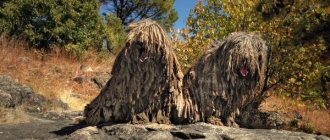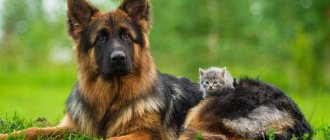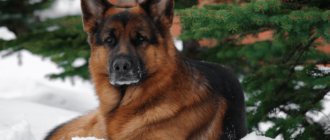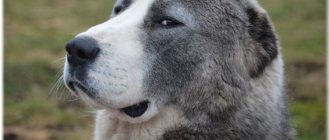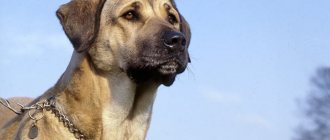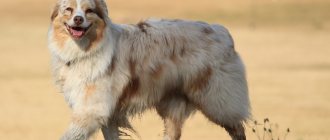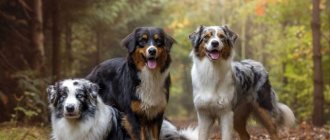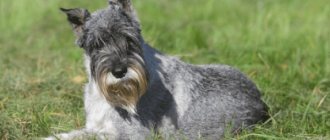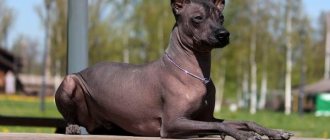Magnificent appearance and flexible character, remarkable strength and sharp mind, courage and incredible endurance, an innate instinct of a guard and defender, love of freedom and boundless devotion to people - the Asian Shepherd (Alabai) possesses all these qualities. Modern varieties of Alabai owe their numerous advantages to their ancient ancestors - Asian Molossians.
Today, like many millennia ago, Asian Shepherd dogs conscientiously and selflessly perform guard duty, protecting farm animals on pastures from cattle thieves and wild predators. If this unique animal is adopted for the home, then the owners find a reliable guardian of order and security and an excellent companion, a loyal friend, a loving and beloved family member.
History of the origin of the Central Asian Shepherd
Alabais or Central Asian Shepherd Dogs are one of the breeds that appeared in ancient times. They are the successors of the molossodid genus - a separate group of dogs to which the herding, herding, herding and fighting varieties of dogs belonged. They began to be bred more than 4 thousand years ago (according to some sources, even during the reign of Alexander the Great) in Assyria and Egypt, then these animals appeared in Hellas and on the territory of the Apennine Peninsula, and over time - in Europe.
The origin of the Alabai as a breed was the result of natural selection and selection intervention. The main purpose of these dogs is to guard and protect caravans of nomadic herder tribes, their homes and livestock. They were also used in hunting, as well as during military clashes. The main factors for the formation of a fearless character and unique physical characteristics (incredible endurance and strength, powerful physique and thick skin with thick dense hair) were the most difficult living conditions and the need to constantly confront jackals and wild wolves. The strongest representatives of this breed managed to survive in such an environment.
People also played a role in transforming the character of Asians. The fact is that these dogs were initially distinguished by their aggressive disposition, so shepherd dogs that posed a clear threat to people were destroyed in childhood. And as a result of cruel artificial selection, it was possible to achieve a loyal attitude of these dogs towards humans.
In the 30s of the last century, a new turn was outlined in the history of the Alabai breed: Soviet dog handlers became interested in the animals. The dogs, which had spread throughout Asia by that time, began to be used in military service and to protect government facilities. For “retraining” they began to be brought en masse to the Union. However, this idea turned out to be unpromising: attempts at mass training failed due to the psychological characteristics of Central Asian shepherd dogs. They turned out to be wayward, and in comparison with Eastern European, German and other service breeds of shepherd dogs - generally uncontrollable.
But the interest of scientists in these amazing dogs did not fade away, and by the end of the twentieth century, the Turkmen Alabai was bred on the basis of the Turkmen wolfhound, which has family ties with Afghan and Mongolian shepherd dogs, Tibetan and Spanish mastiffs. In 1990, this breed was added to the classification as an aboriginal breed and received the official name “Central Asian Shepherd Dog”. In 2003, FCI and RKF experts made final changes to the standard for this breed.
The name “alabai” has Turkic roots and characterizes the color and appearance of the dogs: the word “ala” is translated as “motley”, and “bai” means luxurious. The Uzbeks call these shepherd dogs buribasar, which means “guardian of the herd,” and the Kazakhs call them tobet (translated as “watchdog”).
In the ranking of the most powerful dogs in the world, the Asian takes third place. St. Bernard and Newfoundland surpass it in this parameter.
In Turkmenistan, all purebred Alabai have the status of national treasure of the country, and therefore it is strictly prohibited to export adult dogs and puppies abroad. This qualifies as smuggling.
Kazakh men considered Central Asian Shepherds to be among the attributes of wealth and a good life. In terms of importance, they were not inferior to the owner’s wife and son, his horse and hunting golden eagle, knife and trap.
In many countries, it is prohibited to keep and breed Alabais; they are included in the list of dangerous breeds.
Interesting Facts
Buryat-Mongolian wolfhound
It has been known since ancient times as a guard dog of the indigenous nomadic tribes of Buryatia, Siberia, China and Tibet. They were kept at monasteries, guarded livestock and houses, and took them hunting. These dogs were considered sacred.
The second name of the Buryat-Mongolian wolfhound breed is Khotosho.
In Mongolia and Buryatia there is a legend according to which these wolfhounds have four eyes and they bring happiness to their owners. At the end of the 19th century they disappeared, but were restored in the second half of the 20th century.
Appearance characteristics:
- The wolfhound's size is rather large: males grow up to 75 centimeters, females - no less than 65 cm; Adults weigh about 75 kg.
- Amazingly proportional physique. The head and body are large. The muzzle is short in length and wide, firmly set.
- The eyes are oval, their color ranges from yellowish to chocolate.
- Pronounced chest and withers.
- The paws are massive and muscular.
- There are two breeds: long-haired and short-haired. The coat is dense, different on the paws, and has a water-repellent property - to dry, the dog only needs to shake himself off. Closer to winter, the coat becomes longer and denser, but by summer the wolfhound sheds. Thanks to this feature, it feels good at any time of the year.
- The color of a wolfhound can be black, dark brown with a reddish tint, red with white spots, or wolf color.
The character of the Buryat-Mongolian wolfhound is calm, good-natured, affectionate and even witty. He is charmingly curious: he is interested in everything new that has appeared or is out of place, everything that moves. And he’s not just interested - he’ll force the owner to look at it. A wonderful nanny for children.
We advise you to familiarize yourself with the best dog breeds for children.
For him, the main thing is to protect his space and family members. Gets along well with other pets.
The wolfhound is very undemanding about the environment and feeding, and can settle down anywhere. The dog’s sense of humor is peculiar: having pretended to be very determined, he runs towards the one with whom he wants to play, but at the very last moment, having only touched, he runs past, as if inviting him to run together.
But not everything is so perfect: if the Buryat-Mongolian wolfhound decides that its owner treats it incorrectly, it will not carry out commands.
Important! Due to late physical and psychological development, effective work in wolfhounds begins only after 3 years.
However, a wonderful mind, calm character and amazing adaptability to new conditions turn the Buryat-Mongolian wolfhound into a true friend.
Description of the Alabai breed
Alabais or Central Asian Shepherds are divided into native and hybrid species. The first appeared as a result of the natural evolution of the breed, and the second were bred through selection. The main ones are Turkmen, Tajik, Kazakh and Uzbek varieties, but other types and species of Alabay are also actively used in various regions of Russia and Central Asia. Below are some of them:
- Turkmen alabai. It is the original species and founder of the breed. It is distinguished by its large size and balanced character, and has excellent guarding and herding instincts.
- Coplon leopard. An indigenous species that lives in Central Asia. This variety of Alabaev is distinguished by its wayward, uncontrollable and aggressive character. Such dogs are virtually impossible to train.
- Kazakh alabai or tobet. It is one of the rare species of Central Asian Shepherd Dogs, it is lighter in weight, due to which it has greater endurance and can easily cover significant distances by running. Tobets are used as guard dogs.
- Tibetan Alabai. This is a hybrid, very rare species, which is the product of crossing the Tibetan Mastiff and the Turkmen Alabai.
- Armenian alabai. The homeland of these dogs is the Armenian Highlands. There are two subspecies - with short and long coats, the common characteristics of which are impressive size and very powerful jaws.
- Uzbek alabai (buribasar). This variety differs from the classic CAO in its smaller size, more graceful physique, slightly elongated body and elongated muzzle.
- Siberian Alabai. Refers to hybrid species. He is a cross between a Husky and a German Shepherd. These dogs are distinguished by well-developed intelligence, obedience and affection for humans.
- Turkish alabai (kangal). It has excellent herding qualities and easily manages huge flocks. Compared to their brothers, Kangals are peaceful and obedient, but can make decisions on their own. They show their love and devotion not only to their owner, but also to other family members.
- Caucasian Alabai. Hybrid of Caucasian Shepherd and Alabai. This species inherited all the advantages of both breeds: powerful body, endurance and balanced character.
The behavioral characteristics of Asian Shepherds and the characteristics of the breed in terms of external data have significant differences, due not only to the origin of a particular species, but also to its natural habitat. For example, mountain dogs have a more massive structure and are better adapted to extreme climatic conditions: the coat is longer and denser than that of the steppe varieties of Alabais. Their center of gravity is lower, and their vestibular apparatus is well developed, which helps them maintain balance in mountainous terrain. These dogs have a calm and balanced character; they do not require constant contact with humans.
Asian Shepherds living in steppe regions have completely different breed characteristics. These dogs are distinguished by light bones and high legs. In flat areas, smooth-haired types of Alabais are more common. Some varieties have hunting skills, indicating their possible relationship with the eastern Taza hound. Steppe dogs are distinguished by their agile psyche, sociability and ability to learn.
Size and appearance
The Asian Shepherd dog breed is characterized by a wide variety of exterior shapes, sizes and coat lengths. However, all high-breed varieties of the SAO have a strong athletic build, impressive size, massive heads and powerful jaws. These dogs captivate with their rich facial expressions and the humanly intelligent expression of their beautiful eyes.
Alabais have a thick, hard, straight coat with a dense undercoat. Their “fur coats” have the amazing property of remaining clean in the rainiest and slushiest weather; dirt simply does not stick to the fur. These dogs also lack the usual dog smell.
Because of their very thick fluffy fur, thick paws and short ears, Asian Shepherd puppies look like little bear cubs.
The table below provides a general description of the Central Asian Shepherd Dog breed:
| Height | The height at the withers for females is 60-69 cm, for males – from 70 cm. |
| Weight | Adult females weigh from 40 to 65 kg, in males the weight ranges from 50 to 85 kg and above. |
| Head | Large, proportional to the overall build, almost rectangular in shape. The occipital protuberance is well developed, the cranial part is long and flat, the border between the frontal bone and the bridge of the nose is moderately pronounced. |
| Muzzle | Medium length, blunt shape, practically not narrowed towards the nose. Well defined chin. The bridge of the nose is straight, but, according to the standard, a slight hooked nose is allowed. The lobe is large, black or lightened (in fawn and white varieties). The lips are predominantly black pigmented. The lower jaw is covered by the upper lip. The jaws are strong and wide, the teeth (42 canines) are even and white, the bite type is scissor-shaped. |
| Ears | Triangular, hanging, set low. According to the breed standard, ears can be either cropped or left uncropped. |
| Eyes | Widely spaced, medium in size, oval in shape, color can vary from dark brown to light. Eyelids black. |
| Neck | Muscular, medium length, prominent dewlap. |
| Breast | Long, wide and deep, widening towards the back. The lower part is at the level of the elbows, sometimes even lower. |
| Frame | The back is wide, straight, muscular. The lumbar region is short, powerful, slightly convex. The stomach is taut. |
| Tail | Set high, thick at the base, crescent-shaped when uncropped. The last third of the length is sometimes curled into a ring. The breed standard allows for docked or natural tail options. |
| Legs | Muscular with strong bones, straight, parallel. The hind legs are set slightly wider than the front legs. |
| Paws | Large in size, round in shape, fingers with elastic and dense pads gathered into a ball. The claws are predominantly dark in color. |
| Skin covering | Smooth, dense, elastic and mobile. |
| Wool | Rough, thick, straight. The undercoat is very dense and warm. In short-haired varieties, the length of the coat ranges from 3 to 5 cm, in long-haired varieties - from 5 to 10 cm. Dogs of the second type have a small mane on the neck. |
| Color | The standard allows for a wide palette of color combinations, with the only exceptions being colors that contain blue-gray, brown, red brick and sable shades. |
Lifespan
This breed was formed almost completely independently over several millennia in the most severe conditions; its representatives have a higher vitality compared to their artificially created counterparts. Thanks to this, purebred Alabais live several years longer than other giant and large dogs. Their average life span is 12-15 years. For non-purebred dogs, this period is approximately 25% less.
The health status of Alabai and living conditions largely affect life expectancy. With appropriate care and physical activity, her age limit increases by another 1-2 years - up to 16-17 years. This is why such dogs should not be kept in an apartment or on a chain. They need free range or a spacious enclosure.
Life expectancy among Asians also depends on gender. The fact is that females often suffer from pathological infertility, as a result of which they can develop pyometra, which often causes the death of the animal. In this regard, if the bitch is not planned to be used for breeding offspring, it is recommended to sterilize her.
Age compared to human years (table)
| Alabai age | Person's age |
| 1 year | 15 years |
| 2 years | 24 years |
| 3 years | 28 years |
| 4 years | 32 years |
| 5 years | 36 years |
| 6 years | 45 years |
| 7 years | 50 years |
| 8 years | 55 years |
| 9 years | 61 years old |
| 10 years | 66 years old |
| 11 years | 72 years old |
| 12 years | 77 years old |
| 13 years | 82 years old |
| 14 years | 88 years old |
| 15 years | 93 years old |
Character
The higher nervous activity of Alabais belongs to the balanced-calm type. Their mental processes are balanced, as evidenced by behavioral reactions such as calmness and lack of fussiness. Bitches have a more dynamic mental makeup compared to males. Compared to the sociability and activity of females, males look rather phlegmatic.
The character of Central Asian Shepherds is characterized by such traits as endurance, independence, pride, self-confidence and some arrogance. Dogs of this breed treat strangers with distrust, wariness, and sometimes aggression, while they show incredible sensitivity to the mood of their owner.
The disadvantages of Alabais include stubbornness, love of freedom, independence and vindictiveness. These animals do not tolerate being chained, they are able to think and make their own decisions, and do not forgive insults.
To protect the local area, it is strictly not recommended to have several same-sex Alabais. This will inevitably lead to their mutual struggle for leadership. In male dogs, such fights are usually of a very serious nature, which is called “life and death.”
Two bitches will also conflict, but their fights are more smoothed out in nature.
The optimal option is to have two animals of different sexes in the same territory. The female Alabai is always the first to sense danger and pushes the phlegmatic male to action.
Dog trainer advice
Feeding
Central Asian Shepherds do not eat as much as they might seem. Feeding a pet comes down to creating a diet “according to needs.” It is important to understand that, given the high energy content, food should not contain large amounts of carbohydrates (especially for young dogs). Diet adjustments are made by monitoring weight gain; obesity is an extremely undesirable disease that has a detrimental effect on the dog’s joints and heart.
The best option is natural feeding , that is, meat, cereals, vegetables and fruits. Usually, Asians are given moslaks, but not as food, but as a toy. Fish is not that important, but ocean varieties are rich in trace elements and essential amino acids. Dairy products are useful, provided that the dog itself wants to consume them and does not experience stomach upset afterwards.
Important! It is necessary to regularly include vitamin supplements in the natural diet.
Feed can be considered as an alternative. Naturally, the products should be designed for large and fast-growing breeds. Until the age of 3, the pet should receive food with a strengthened composition. Product class is not lower than premium, for puppies and old dogs, not lower than super-premium.
Attitude towards others
Alabai treats strangers with distrust and wariness, and at any moment is ready to rush to the defense of his owner and his family members. However, this does not mean that these dogs attack without reason and on anyone. One of the advantages of the Central Asian Shepherd is restraint and the ability to adequately assess the situation. That is, if the stranger does not show aggression and pose a danger to people close to the dog, it will not show its protective abilities.
Another feature of the alabai is that it jealously guards “its” territory and categorically does not tolerate strangers violating the boundaries it has established. In a neutral space, these dogs display an arrogant indifference towards strangers. Despite this, a strong leash and muzzle are mandatory attributes for walking Central Asian Shepherds.
The behavioral characteristics of Alabais are determined by gender differences. Males are prone to straightforward actions: they attack strangers quickly, without any warning signal. Bitches initially try to solve the problem by barking warningly and blocking the road, and attack only when preventive measures have no effect.
Central Asian Shepherd Dogs show extreme intolerance towards animals that do not belong to the circle of “family members”. They demonstrate their hostility especially sharply towards four-legged animals unknown to them. Moreover, serious confrontation is observed even between Alabai males.
This behavior is explained by factors that influenced the formation of the character of these dogs. In ancient times, Alabais were used for dog fighting, as a result of which they developed a persistent dislike for their own kind. And the constant need to protect livestock and other household animals from wild animals has led to the fact that Asians see potential enemies in all unfamiliar animals.
Interesting Facts
Attitude towards children
Rapid social adaptation is one of the characteristic features of almost all varieties of Alabais. Dogs of this breed easily find their place and feel comfortable in a human family. Asians have respect and love for their master, and they treat other members of the “pack” kindly and peacefully.
These formidable dogs have a special relationship with children. They do not divide them into friends and foes, and demonstrate condescension, patience and care towards the younger members of the “pack”. However, you should not take advantage of this and assign the duties of an uncomplaining nanny to the alabai. Always remember the character, size and purpose of the dog. Even without wanting to harm a child, this huge dog can accidentally injure him, for example, during play.
Intelligence
Alabais are among the very smart breeds. Innate willfulness and high intelligence do not allow them to mindlessly obey commands. Any step they take is motivated and justified. Before performing it, these animals think, evaluate the situation and the appropriateness of a particular action, and only after that make an independent decision.
Asians are capable of cunning and manipulating people, which also speaks of their developed mental abilities. If, for example, the dog does not see the need or he simply has no desire to carry out this or that command, he can pretend to be sick.
The “organizational” abilities of the Alabai deserve special attention. A pair of dogs can keep several hundred sheep under control, preventing members of the herd from straying beyond the boundaries they have set. Shepherds often leave their livestock in the full care of their four-legged helpers.
Owner reviews
Frankly speaking, not everyone is able to have such a breed in a city, and here, if the owner copes with all his responsibilities properly, a monument should be erected to him; such a person himself must be provided for and stand firmly on his feet financially, first of all, in terms of. Not to mention personal responsibility.
Those who have endured and are still bearing on their shoulders all the hardships associated with close friendship with the Alabai (read, living together with him and properly caring for him), first of all note that these dogs are certainly smart, and if they bark, then only for the sake of business, to “further ostracize” the stranger, and that with proper upbringing, such a dog can rightfully be called golden.
They also say that in the city such dogs do not live to their middle years and die at the age of nine and ten.
Education and training
The process of properly raising a Central Asian Shepherd is fraught with considerable difficulties and requires the most responsible attitude and enormous patience. It will take at least 3 years to develop the correct behavior and necessary skills in a dog, and it is necessary to work with the puppy immediately after arriving in the house.
A prerequisite is systematic training. Training is carried out daily for half an hour. It will be a positive thing if parenting lessons take place with the participation of other family members. Upon reaching the age of seven months, the puppy must know and follow the basic commands: “Ugh!”, “Come to me!”, “Place!”, “Sit!” etc.
In order to raise a brave guard from a cute plush ball, you should initially stop all attempts by strangers to play with the puppy, touch it or feed it. A devoted friend and reliable protector can be raised provided that the correct contact with the dog is initially established.
Dog trainer advice
Alabais are very capricious and do not like to obey. They have a highly developed sense of the leader of the pack. To achieve the desired result, you need to convince the dog that you are the leader. Otherwise, he will grow up uncontrollable and dangerous. The process of gaining authority from a dog should not be accompanied by cruel treatment in the form of shouting and punishment. Remember that Asians are very touchy and vindictive, so sooner or later they can take revenge for an insulting attitude towards themselves.
Constant encouragement helps to establish mutual understanding with your pet: a kind word, a favorite treat or a friendly stroke are the best ways to get good behavior and obedience from your dog.
An important role in the process of raising an Alabai is played by his gender. Training male dogs is much easier, since by their nature they are somewhat simpler and more naive than females, who have a more subtle mentality. The girls are quite cunning and inventive; they use various tricks to avoid fulfilling the owner’s demands.
The Central Asian Shepherd is a complex breed that requires a professional approach to training, so it is better to entrust this important process to a qualified specialist. Only a competent dog handler can turn a stubborn little dog into a real watchdog.
Are boys different from girls?
During the first 6 months of life, the exterior of Alabai dogs is identical in males and females, and it is impossible to determine the gender of a puppy just by looking at it.
When dogs reach the age of 9-10 months, their exterior differences are already pronounced. The male's height at the withers reaches 80 cm, he weighs about 70 kg and has a massive overweight body and a bear-like large head. the girl, in turn, has a more graceful silhouette, she grows up to 70 cm at the withers and weighs 60 kg.
Health and illness
Purebred Central Asian Shepherds inherited excellent health and excellent immunity from their ancient ancestors. But these strong and hardy animals are also not immune to illness. Diseases of Alabai are associated with genetic factors and improper maintenance.
The most common problem among Asians is musculoskeletal disorders. This occurs due to their large mass. Due to increased loads, the knee and hip joints are seriously damaged.
With short walks, the dog becomes obese, which will lead to diseases of the cardiovascular system and various forms of arthrosis or arthritis. The latter are accompanied by severe pain, which means that your pet will experience unbearable suffering. To effectively prevent obesity in Alabai, it is necessary to properly organize its diet: the feed must contain the required amount of calcium, magnesium, phosphorus and other microelements. Be sure to pay attention to the dog’s physical activity.
Due to an unbalanced diet, metabolism can also be disrupted, which can lead to diabetes. Always remember that food from a human table poses a risk to the health of your four-legged pet. In addition, it is necessary to select specialized dog food very responsibly, since some of them cause allergies in animals.
The presence of helminths in the animal’s body is another serious problem. A dog infected with parasites becomes lethargic, loses appetite, and loses weight. To avoid such problems, the pet must be dewormed twice a year.
Ticks and fleas can also cause a lot of serious troubles such as demodicosis and other diseases. An effective method of protection against these dangerous blood-sucking insects is a special collar to combat ectoparasites. And also for the prevention and treatment of such diseases, a variety of drugs are used for external and internal use. However, it should be borne in mind that all of them are very toxic, so they should be used under the supervision of a veterinarian.
Varieties of alabai according to place of “registration”
Turkmen Central Asian Shepherd Dogs are characterized by a proportional build.
These are strong and hardy pets with very fast reactions and a high pain threshold.
Photo 1. Alabais are big and smart dogs
Like other shepherd dogs of this breed, Turkmen dogs are characterized by high intelligence.
Tajik Central Asian Shepherds are distinguished by their heavier external shape, which makes them look like St. Bernards. These dogs are also characterized by a longer coat.
Alabaev, originally from Uzbekistan , is distinguished from the rest by his shorter stature and “lighter” external constitution. These representatives of shepherd dogs are already closer to greyhounds and show greater activity and endurance.
Kazakh Alabais are classic representatives of Central Asian Shepherds as we imagine them.
The appearance of these large dogs causes many people unfamiliar with the detailed description of the breed to confuse them with St. Bernards, Caucasian Shepherds, Bernese Mountain Dogs or Moscow Watchdogs...
Care and maintenance
People who want to own a Central Asian Shepherd must clearly understand that this is a special breed and it requires the creation of certain conditions for a full life.
Housing issue. Let us immediately note that the Alabai is not an apartment dog. He needs space and open air. Even the garden area in a private house should be quite large for the dog to feel comfortable. Life on the move is definitely about Alabai. Their physical, mental health and life expectancy depend on this, so keeping them in chains is strictly prohibited.
The Asian’s “residence” should be a free enclosure with a large, comfortable booth. To set up the enclosure, choose a slightly elevated area, protected from the wind. In summer, care should be taken to shade this area. The booth must be spacious, it is built of wood, must be thermally insulated and installed on low bars to prevent water from entering. It is necessary to dig a pole in the enclosure and attach a metal ring to it to temporarily tether the dog.
Walking rules. Puppies begin to be walked from the age of three months. The pet must be accustomed to a leash and muzzle. For walks, it is recommended to choose places that are not popular with dog walkers. The average duration of one walk is an hour, the number of walks per day is at least 2.
Hygiene. An important question is how to care for Alabai? The level of comfort, well-being and even the life of the dog depends on the quality of care. Remember that cleanliness is the key to health not only for humans, but also for animals. The place where the pet is kept must be regularly tidied up: cleaned of debris and hair, shaken out, washed or changed bedding, and monthly wet cleaning of the kennel and the area of the enclosure. Every six months it is recommended to completely disinfect the Asian’s place of residence using special means.
The set of dog hygiene procedures includes:
- daily brushing and combing of the coat;
- regular examination of the ears: if mites, dark discharge and other problems are detected, you should immediately contact a veterinarian;
- wiping the ears using a damp cloth or cotton swab soaked in a 3% solution of hydrogen peroxide (this event is carried out 2 times a month);
- daily inspection of the paws for foreign bodies and damage, trimming the claws as necessary;
- regular inspection and cleaning of the nose from contaminants using a soft cloth and warm water (in a healthy animal, the nose is cold and wet, without any discharge);
- eye care: any discharge that appears is removed with a gauze swab dipped in chamomile decoction;
- cleaning teeth: stuck bone fragments and other small objects are carefully removed with a wooden skewer or tweezers; preventive cleaning with a toothbrush and paste is carried out every 2 weeks (instead of paste, you can use a solution of school chalk with a few drops of lemon juice or baking soda);
- bathing (the procedure is carried out once a month, but not more often);
- deworming and vaccination (according to schedule).
Rules for feeding Alabai. A balanced diet includes the following foods:
- raw meat - veal and beef (puppies up to 3 months of age are given boiled or steamed meat);
- chicken or turkey, cleaned of bones and entrails (poultry is not often fed);
- any beef offal (liver must be boiled);
- low-fat sea fish;
- porridge (oatmeal, rice, buckwheat);
- fermented milk products (preferably from goat's milk);
- eggs;
- vegetables (carrots, cabbage, pumpkin, zucchini, cucumbers, tomatoes, garlic, lettuce) and fruits (apples);
- nuts and berries;
- chewing bones made from bovine sinews.
The list of prohibited products includes:
- any food from a person’s table;
- sweet dishes, white bread and pastries;
- broths;
- pork;
- any types of bones (boiled tubular bones are especially dangerous);
- cereals (pearl barley, semolina, barley, oatmeal, millet);
- vegetables (beets, potatoes, onions), exotic fruits and all types of citrus fruits, sorrel and any legumes;
- salted, pickled, smoked and canned foods;
- seasonings and spices.
It is important
All types of products (except cereals) are given to alabai in raw form.
The food should be at room temperature.
The dog is provided with constant access to fresh, clean water.
The diet for adult animals includes two meals a day. For puppies, the maximum number of lunch breaks depends on age: babies under 3 months are fed 6 times a day, with each month the intervals between meals increases and the number of lunches decreases. From six months to one year of age, puppies can be fed no more than 3 times a day.
If the dog has not eaten the entire portion of food within 15 minutes, the leftovers are removed before the next meal.
it is important
Kyrgyz greyhound Taigan
Another extremely rare national dog breed, almost on the verge of extinction. The only one officially recognized in Kyrgyzstan. Product of folk selection. Despite some similarities with tazy, the taigan is an independent species. Although in border areas crosses of these two breeds are bred.
Taigans are considered a universal hunting dog for the mountains. In addition to hunting, this greyhound was used to guard livestock and the homes of nomads.
Despite his indifference to strangers, the taigan knows how to track down and bark at a thief. The coat is elongated, with developed hair on the ears, paws and tail. These are balanced dogs, and at the same time excellent hunters, they are vicious towards the beast.
Add a comment Cancel reply
Application
The Central Asian Shepherd Dog is a multifunctional breed, but its watchdog qualities are most clearly expressed. Currently, these dogs are used for protection and security.
- farm animals and control over them in grazing;
- entrusted objects and territories, including industrial zones;
- private households and their owners.
Some varieties of alabai are used for hunting. In the past, representatives of this breed were exploited as a draft force, and were also trained as fighting dogs to participate in canine gladiatorial tournaments.
Kinds
One type of this breed has been standardized. But, it can be divided depending on the color of the coat. Alabais are born pure black, white, spotted, gray, black and white, light red and beige-red. The most valuable representative of the breed is black with white markings on the neck, chest and back. It costs significantly more.
Advantages and disadvantages
The Central Asian Shepherd is a rather controversial breed, which has a considerable number of positive and negative characteristics.
The undoubted advantages of the Alabai include:
- innate qualities of a guard and protector, high intelligence;
- immense devotion to the owner and members of his family;
- cleanliness and asceticism in terms of living conditions;
- unpretentiousness in food and moderate appetite, despite its enormous size;
- endurance and excellent tolerance to all weather conditions;
- loyal attitude towards others outside one’s territory.
The disadvantages of Asians and difficulties are associated with their content. These include:
- the need for a large area for living;
- demands for physical activity and long walks;
- stubbornness and willfulness, reluctant submission to the owner;
- a sense of leadership in the family (a person without a strong character will not be able to gain authority and respect from this dog);
- the need for professional training;
- aggressive attitude towards foreign animals;
- desire for freedom, tendency to vagrancy;
- low level of socialization.
Alabai breeding
Alabais are unpampered dogs. Since the breed was formed in very difficult conditions, modern Asians are unpretentious. Anyone who wants to have such a pet should know that finding a common language with him is not always easy. Alabai needs an owner with a strong character. This is a very important point, since it determines who the friendly puppy will turn into over time - a reliable friend and watchman or an aggressive animal.
Important fact: Central Asian Shepherd Dogs are not suitable for living in an apartment. They need a fairly spacious enclosure, regular exercise or a daily walk for a couple of hours. When walking, be sure to use a reliable leash and muzzle.
The best option for living a wolfhound is the local area of a private house. Children can be kept in an apartment. They need comfort and warmth. Every Alabai should have a personal space where he can retire and relax in silence.
Only household members and other pets with whom the puppy has lived in the same territory since birth will be perceived by the adult dog as their own. Everyone else will be strangers. For this reason, if the future owner of the dog likes to receive guests in the house, then he should refuse to have this pet.
The guard instinct of Central Asian Shepherds is very pronounced, which can create certain problems. Breeding Alabais is a very difficult task. Every mistake of the owner or his cowardice can cause a tragedy in the future.
How to choose an Asian Shepherd puppy
So, after weighing all the pros and cons, you have firmly decided to get an Alabai and even decided on the gender of your future pet. But this does not mean that you have to rush to the first kennel you come across to pick up a dog. Purchasing a Central Asian Shepherd is a responsible process, so you need to seriously prepare so as not to buy yourself a big problem from an unscrupulous breeder.
First you need to get advice from a specialist, or better yet, go with him to the nursery. Before choosing a specific candidate, look at several litters. If the opportunity arises, visit a dog show.
Before buying a puppy, pay attention to the following aspects:
- breeder's reputation;
- living conditions for parents and children;
- appearance of puppies and adult dogs (does external data correspond to breed standards);
- on the behavior and visual health of offspring;
- for the presence of metrics and certificates for children.
It is recommended to purchase puppies that are at least 7 weeks old. Consider active, moderately curious, non-fearful and non-aggressive fluffies as potential candidates. The kittens must have the correct bite and good appetite. There is no need to choose the largest or smallest specimen, even if you liked one of them.
Price range
A pet with a defect will cost an average of 10-12 thousand rubles, without a defect, but nondescript in appearance, a little higher - 15 thousand rubles.
Alabai with a rich pedigree and no less broad prospects - 20-45 thousand rubles.
There are many factors that influence the cost of a breed: pedigree, appearance, coat color (white “bears” are more promising than spotted ones), presence of defects, region. Another thing is the size; it does not affect the price of purchasing an Alabai puppy.

